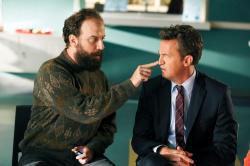Go On, NBC’s latest attempt to rekindle the old Friends magic by cloning at least part of its DNA, puts too much faith in Matthew Perry’s mugging. Sure, the guy has a great wrinkly-eyed grin, but at least 10 percent of each episode is devoted to extreme close-ups of Perry’s facial expressions as he works through puzzlement and annoyance before settling on wry amusement. Everything that happens at the sports radio station where he works (another sitcom sports journalist!) is credibility-stretching nonsense, and a couple of the more cartoonish members of his transitions support group need to go.
But the show has made at least one brilliant decision: Its self-help circle is TV’s smartest setting.
Most programs have to decide between work and leisure. If a show is based in an office or a school, daytime plots will dominate. If the bulk of the action takes place in a bar or an apartment building, nighttime storylines work best. Of course, daytime colleagues can socialize at night—the Pawnee Parks and Recreation department might spend an evening at the Snakehole Lounge, the students of McKinley High share a meal at Breadstix—but their common bonds begin in the daylight hours.
Some shows shift their centers: Cougar Town began as a show about the foxy middle-aged ladies in a real-estate office and found its sweet spot when the cul-de-sac crew migrated to Jules’ open-plan living room. And, of course, there are utility settings: Spaceships, prisons, and country houses don’t allow for an easy exit, so stories can take place there day or night. But those locations are pretty limiting. A support group can be assembled any time and in more or less any place.
And then there’s the homogeneity factor. Whatever diversity American high schools and colleges might offer, everyone’s more or less the same age. (Community is an honorable exception: Some of Greendale’s seniors are senior citizens.) Offices, apartment buildings, and police stations all attract people with similar skills, incomes, and attitudes. Go On’s group is different. There’s an old blind guy, a middle-aged lesbian, a bereaved young man, an Army veteran, an uptight Asian lady, a sad Latina, a white cat lady, and a perv.
It’s a brilliant device that allows the characters to cross boundaries of class, race, and culture—at least temporarily. All kinds of people end up in hospitals and courtrooms—and on medical and legal dramas—but they need doctors and lawyers to rescue them. The members of the Go On support group are grieving, lonely, and odd, but they’re going to help each other get better.
